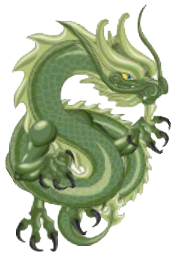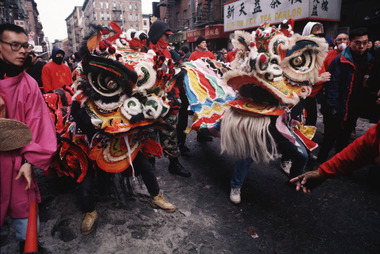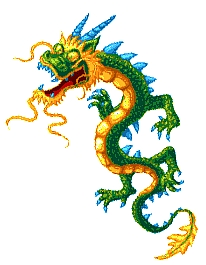The Chinese Dragon Biography
Source(google.com.pk)
There are nine major types of Chinese dragons. These include the horned dragon, the winged dragon, the celestial dragon (which supports and protects the mansions of the gods), the spiritual dragon which generates wind and rain for the benefit of mankind), the dragon of hidden treasures (which keeps guard over concealed wealth), the coiling dragon (which lives in water), and the yellow dragon (which once emerged from water and presented the legendary Emperor Fu Shi with the elements of writing)
The last of the nine is the dragon king, which actually consists of four separate dragons, each of which rules over one of the four seas, those of the east, south, west, and north.
The most powerful generalized type of Chinese dragon is the horned dragon, or lung, which can produce rain and is totally deaf. Additionally, there is a homeless dragon (Ii) that lives in the ocean and another type (chiao) that is scale-covered and usually inhabits marshes but also keeps dens in the mountains.
There are also nine ways the Chinese have traditionally represented these dragons, each one revealing a different dragon characteristic. There are dragons carved on the tops of bells and gongs, because of the beast's habit of calling loudly when attacked.
A second type is carved on the screws of fiddles, since most dragons are fond of music.
A third is carved on the tops of stone tablets, because of dragons' love of literature.
A fourth is found at the bottom of stone monuments, as dragons can support heavy weights.
A fifth is placed on the eaves of temples, as dragons are ever alert to danger.
A sixth occurs on the beams of bridges, since dragons are fond of water.
A seventh is carved on Buddha's throne, as dragons like to rest.
An eighth is placed on the hilts of swords, since dragons are known to be capable of slaughter.
The ninth is carved on prison gates, as these are dragons that are fond of quarreling and trouble making.
The colors of Chinese dragons are evidently quite variable, but in the case of the chiao type its back is striped with green, its sides are yellow, and it is crimson underneath.
The nine major characteristics of a lung type dragon include a head like a camel's, horns like a deer's, eyes like a hare's, ears like a bull's, a neck like an iguana's, a belly like a frog's, scales like a carp's, paws like a tiger's, and claws like an eagle's. It has a pair of large canine teeth in its upper jaw. The long, tendril-like whiskers extending from either side of its mouth are probably used for feeling its way along the bottom of muddy ponds.
In color dragons varies from greenish to golden, with a series of alternating short and long spines extending down the back and along the tail, where they become longer. One specimen had wings at its side, and walked on top of the water. Another tossed its mane back and forth making noises that sounded like a flute.
Cow-heads are also common. A ten-footer, found lying on the banks of China's Yangtze River, was different from most because of its long, thick eyebrows. A Yellow River variety, seen on shore in the 1920s by a Chinese teacher, was bright blue, and as big as five cows. Both dragons crawled into the water as soon as it started to rain.
A few dragons begin life as fish. Carp, who successfully jump rapids and leap over waterfalls, change into fish-dragons. A popular saying, "The carp has leaped through the dragon's gate," means success, especially for students who have passed their exams.
Male dragons sometimes mate with other species of animal. A dragon fathers an elephant when he mates with a pig, and he sires a racehorse, after mating with a mare.
The Chinese dragon is as a symbol of auspicious power in Chinese folklore and art, it is the embodiment of the concept of yang [male] and associated with the weather and water as the bringer of rain.
Chinese dragons are believed to be the rulers of moving bodies of water, such as waterfalls, rivers, or seas. They can show themselves as water spouts (tornado or twister over water). There are four major dragons, one representing each sea. For instance the Dragon King of the Eastern Sea, Dragon King of the Western Sea, and so forth.
Because of this association, they are seen as "in charge" of water-related weather phenomenon. In premodern times, many Chinese villages (especially those living close to rivers) had temples dedicated to their local "dragon king." In times of drought or flooding, it was customary for the local gentry and government officials to lead the community in offering sacrifices and conducting other religious rites to appease the dragon, either to ask for rain or a cessation thereof.
The Chinese Dragon Chinese Dragon Tattoo Head Dance Symbol Drawing Pictures Parade Costume Mask Images

The Chinese Dragon Chinese Dragon Tattoo Head Dance Symbol Drawing Pictures Parade Costume Mask Images

The Chinese Dragon Chinese Dragon Tattoo Head Dance Symbol Drawing Pictures Parade Costume Mask Images

The Chinese Dragon Chinese Dragon Tattoo Head Dance Symbol Drawing Pictures Parade Costume Mask Images

The Chinese Dragon Chinese Dragon Tattoo Head Dance Symbol Drawing Pictures Parade Costume Mask Images

The Chinese Dragon Chinese Dragon Tattoo Head Dance Symbol Drawing Pictures Parade Costume Mask Images

The Chinese Dragon Chinese Dragon Tattoo Head Dance Symbol Drawing Pictures Parade Costume Mask Images

The Chinese Dragon Chinese Dragon Tattoo Head Dance Symbol Drawing Pictures Parade Costume Mask Images

The Chinese Dragon Chinese Dragon Tattoo Head Dance Symbol Drawing Pictures Parade Costume Mask Images

The Chinese Dragon Chinese Dragon Tattoo Head Dance Symbol Drawing Pictures Parade Costume Mask Images

The Chinese Dragon Chinese Dragon Tattoo Head Dance Symbol Drawing Pictures Parade Costume Mask Images
No comments:
Post a Comment